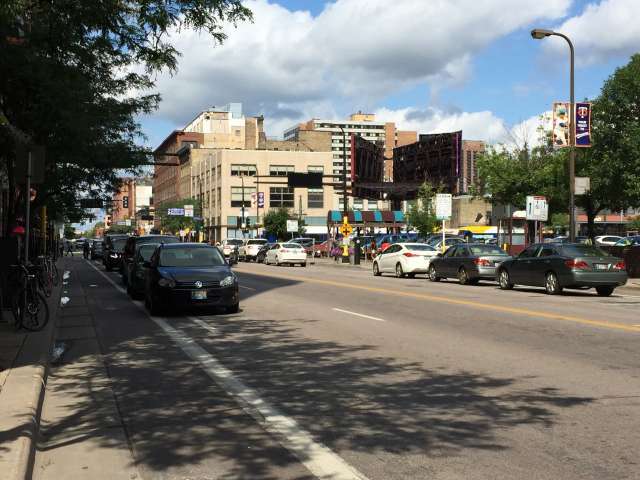
Where can we go with 1st Avenue?
Ethan Fawley & Alex Cecchini : The Journal : January 22, 2016
While we disagree with Dario Anselmo’s assertion in “First Avenue Freeze-Out” that bike lanes are largely to blame for many of 1st Avenue’s current challenges, there is no question that the design of this critical street should be reconsidered.
The right design can help support a thriving 1st Avenue again. Walking and biking advocates are eager to join local businesses, the city, and others to support that solution. We offer one idea below focused on making 1st a more people-focused street.
First a bit of history…
The changes on 1st and Hennepin in 2009 are actually what spurred the creation of the Minneapolis Bicycle Coalition as people who bike were so concerned about the changes. These included elimination of well-used (and terrifying for many) bike lanes on Hennepin and a back-in attempt to “accommodate” people biking on 1st instead. The design was actually proposed as a way to add bike lanes with four lanes for traffic, with the outer two used for parking in off-rush-hour times. That parking and traffic lane dance necessitated the curb-side bike lane. The result was, especially at first, a disaster for biking. While improvements have been made, most cyclists would agree it has never been made a great place to bike because standard features of similar bike lanes in other cities have never been done on 1st. Despite these challenges, the latest bicycle counts saw more than 400 people a day between 4th and 5th Streets on 1st Avenue.
Today: changes are needed, but many assets
Today 1st Avenue as a street really isn’t working as Mr. Anselmo points out. However, street closures after sporting events and bar close have little to do with bike lanes. Rather, the narrow sidewalks are inadequate in supporting busy times — a key problem noted in the Downtown Improvement District Hospitality Zone Assessment. Bike lanes have been shown by manystudies across the country to typically improve commercial vacancies, retail sales and property values. The assertion that bike lanes have been a major contributor, if at all, to increases in crime and commercial vacancies is not supported by evidence elsewhere locally and nationally.
We do agree there are challenges with its current design. Late night is chaotic and oftentimes unsafe, and parking can be confusing and challenging. The sidewalks are too narrow. The bike lane is too narrow for its current configuration, parked cars frequently park in it (creating a safety issue for people on bikes), and it doesn’t connect to many other bicycle facilities downtown.
1st Avenue has many tremendous assets that can be capitalized on, including the many area draws for sports, music, and nightlife. At the same time, it also needs to be a street that works for people every day of the week to leverage the excellent transit access, beautiful historic buildings, and growing residential areas in the North Loop and broader Downtown Minneapolis. The people that populate the streets deserve a safe, welcoming, and lively 1st Avenue befitting of a major 21st Century downtown.
The future: making 1st Avenue a great street for people
To respond to those challenges and maximize these assets, we suggest looking at a solution that invites people to walk on 1st Avenue more and provides the space for lingering at outside cafes. These are by no means new ideas and reflect many of the great ideas we’ve heard from local stakeholders.
In the immediate term, it seems sensible to reconfigure the street with parking against the curb and more standard bike lanes. That would clarify a lot of things for both people parking and biking since the current bike lane has never been implemented well. If we move to one lane in each direction — something that proved feasible with the parklet demonstration this past year — additional parklets could be installed providing greening, pedestrian realm enhancement, and outdoor seating space for restaurants. We understand the City is considering such changes and we are very excited to hear more as we are sure local businesses are as well. Some recommendations from the Hospitality Zone Assessment, such as creating wayfinding, improving transit access points and safety, and better taxi pick-up zones will help with crowded weekend times.
In addition, the Hennepin Avenue reconstruction (currently planned for 2020), provides the potential to move the bike lanes to Hennepin — a route with better local and regional connections. If that move happens, we would fully support removing the bike lanes from 1st to provide additional sidewalk, outdoor seating, and green space to further enhance the walking and business environment and support nighttime crowds.
We hope to continue conversations with Mr. Anselmo and others to find the best solutions for everyone–from local businesses and residents to area walkers, bicyclists, and drivers.
Alex Cecchini is the co-chair of the Programs & Policies Subcommittee of the Minneapolis Pedestrian Advisory Committee. Ethan Fawley is the executive director of the Minneapolis Bicycle Coalition.

